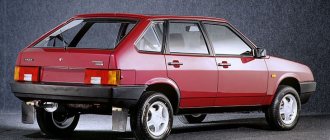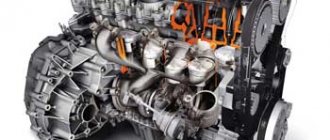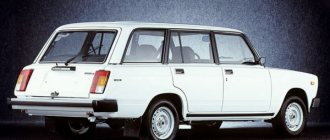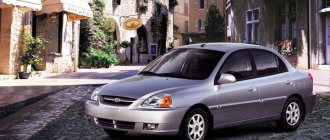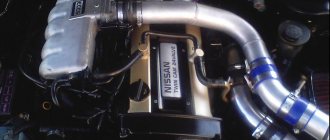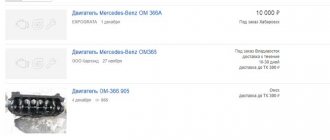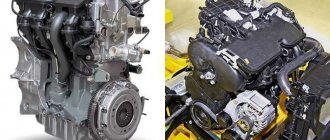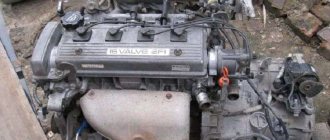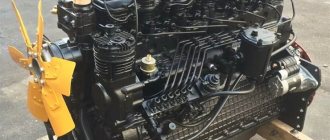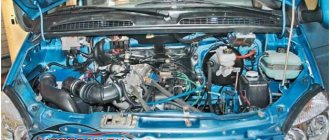The M40 engine family includes two power units - M40B16 and M40B18 with cylinder volumes of 1.6 and 1.8 liters, respectively. In 1987, the German concern created the M40B18 - it became the first in-line 4-cylinder internal combustion engine of this family. A year later, in 1988, on the basis of the M40B18, a unit with a smaller cylinder capacity was created - the M40B16. The reduction in volume also brought about other changes: a crankshaft with a shorter piston stroke, the pistons themselves, etc.
The M40 series engines replaced the outdated M10 family engines. They received successful design solutions of their predecessors and new advantages. Despite the fact that the last M40 engine came out in 1994 (that is, about 15 years ago), cars based on it are still running confidently.
Characteristics, list of cars with M40 engines
The engine parameters correspond to the tables:
| Manufacturing plant | Steyr Plant |
| Cylinder block | Cast iron |
| Power system | Injector |
| Number of cylinders | 4 |
| Number of valves | 2 per cylinder, 8 pieces in total |
| Piston stroke | In M40B16 – 72 mm |
| In M40B18 – 81 mm | |
| Cylinder diameter | 84 mm |
| Compression ratio | 9 |
| Power | M40B16 – 102 hp at 5500 rpm |
| M40B18 – 113 hp at 5500 rpm | |
| Torque | M40B16 – 143 Nm at 4250 rpm |
| M40B18 – 162 Nm at 4250 rpm | |
| Suitable fuel | M40B16 – AI 92-95 |
| M40B18 – AI-92 | |
| Consumption | Up to 10.5 l per 100 km in the city |
| Oil volume | 4 liters |
| Required viscosity | 0W-30, 0W-40, 5W-30, 5W-40, 10W-40, 15W-50 |
| Oil change required | After 10 thousand km; better – after 7000 km. |
| Resource | 300+ thousand km. |
M40B16 were installed on BMW 3-Series E30, E36.
M40B18 was installed on the BMW 3-Series E30, E36, as well as the 5-Series E34 model.
Important changes in the M40 engine compared to the M10 engine
- higher productivity;
- more favorable torque curve;
- improved mechanical performance;
- convenient maintenance and service;
- compact design;
- high efficiency;
The M40 engine differs from its predecessor primarily in increased torque in the range of low and medium speeds.
It is also more powerful and has been designed with ease of care and maintenance in mind.
With greater rigidity, it was possible to achieve 10% less weight than the M10 motor. The cylinders are cast into the block, and the inter-cylinder distance is 91 mm.
Description of motors
Both engines in the M40 family are 4-cylinder units with 8-valve heads, single camshaft and hydraulic lifters. The latter eliminate the need to adjust valve clearances every 10 thousand kilometers. The differences between the engines are minor: the 1.6-liter version uses a different intake manifold, throttle body, ECU and spark plugs. To reduce the volume, the crankshaft and pistons had to be changed.
Both motors have belt-driven chains. Despite the fact that chains are generally better than belt drives, in motors of the M40 family they are weak and have a short service life. Due to the small width, replacement of the roller and timing belt is required every 40 thousand kilometers, and sometimes earlier. Therefore, drivers should listen for a whistle from under the hood and monitor the condition of the chain. This is an obvious drawback of the M40 internal combustion engine, especially compared to other engines whose chain “lives” 200+ thousand kilometers. In addition, in these engines, a broken chain is accompanied by an inevitable impact of the pistons on the valve heads, as a result of which the latter bend.
Unlike the M40B18, the 1.6-liter version received several modifications. From 1988 to 1991, internal combustion engines were produced without catalysts (102 hp, 143 Nm). In the period 1991-1994, models with catalysts were produced - 100 hp. and a torque of 141 Nm. Naturally, the 1.8-liter units were more powerful - 113 hp; torque – 162 Nm.
Engine M40B18
Basic information about the engine
Production of the M40B18 engine started in 1987. The motor is the older brother of the M40B16, which appeared a year later. The engine is the first in-line four-cylinder unit in the M40 family. 1.8-liter M40B18 engines were equipped for BMW 3 Series E30, E36, as well as BMW 5 Series E34. The unit was used on a car with the factory index 18i. In addition, since 1989, a sports modification of the 1.8-liter M40B18 engine has been produced in parallel. In 1992, the power plant was replaced by an updated version of the M43B18.
The basis of the engine is a cast iron cylinder block. It is noticeable in the photo that the block is covered on top with an eight-valve head with a single camshaft. Also in the design of the BMW M40B18 engine there are hydraulic compensators, thanks to which there is no need to adjust the valves every 10,000 km. The diameter of the intake valve is 42 mm, the exhaust valve is 36 mm. The piston stroke on this engine is 81 mm, and the cylinder diameter is 84 mm. The engine is capable of developing maximum power of up to 113 horses at 5500 rpm, along with this, the torque reaches 162 Nm at 4250 rpm.
Problems
And although the M40 series motors are reliable, structurally and technologically sophisticated, they have disadvantages associated primarily with natural wear:
- Knock. Occurs on engines with a mileage of over 200 thousand kilometers. The source is often a worn camshaft, hydraulic lifters or rocker arms.
- Overclocking failure. According to reviews from owners, the problem with the engines lies in the injectors. They need to be cleaned or replaced.
- Swimming revs. The main reason is a crack in the air flow sensor duct, which causes air leaks. If everything is in order with the air duct, then you need to look for the problem in the mass air flow sensor itself, the air flow sensor or the throttle valve. Very rarely the cause is the camshaft.
- Overheat. Everything here is standard and the troubleshooting algorithm is classic: we check the amount of coolant, look for cracks in the radiator or plastic tubes. Rarely, air locks, pumps and thermostats become the cause of overheating.
- Does not start. There are many reasons: the fuel system, including the fuel pump, high-voltage wires, ignition coil, etc.
- A timing chain with a short service life is 40 thousand kilometers. It is extremely important not to miss this moment and replace it in a timely manner. Many owners, relying on the long service life of the chain, forget about the need to replace it, and this leads to its breakage.
Added to these problems is the age of the engine. As of mid-2018, there are no new M40B16 and M40B18 engines, so purchasing an old “three” or “five” from a German concern is not the best solution.
Chip tuning
To increase power characteristics, owners often resort to chip tuning. By the way, tuning on the M40 series of engines is not an economically profitable investment. It’s easier to purchase a used M50 power unit and successfully improve its characteristics.
To improve the power of the M40B18 engine, a stroker is the best option. The procedure consists of increasing the engine capacity to 2.1 liters by replacing the crankshaft from M47D20 with a stroke of 88 mm, machined pistons from S50B30, connecting rods from M44B19. The cylinder head, timing belt, intake and exhaust, and electronic control unit are taken from the M44 engine. The event will allow the engine to produce up to 160 horses.
Installing a turbine on the M40B18 is a better idea due to the high cost, power of 150 horses and a significant reduction in service life.
Source
Tuning options
People don’t intentionally buy M40 engines for tuning; there is a better solution - the BMW M50. However, there are options to modify the M40 and add horsepower to it - a stroker. The volume of a 1.6- or 1.8-liter engine can be increased to 2.1 liters. To do this, the block is bored to 86 mm, pistons from S50B30 are used, connecting rods from M440B19. They also replace the cylinder head, timing belt, exhaust and intake manifolds, and install a control unit from the M44. All this will add to the existing 102 hp. add another 50-60 hp As a result, power will increase to 150-160 hp.
It is also possible in theory to install a supercharger in the form of a turbine, but in practice no one does this. To do this, the engine will have to be redesigned so much that only the cylinder block will remain from the M40. The output will be a 150-horsepower engine with a very short resource.
Engine Description
The BMW M40B18 four-cylinder engine replaces the old M10. It has hydraulic compensators, so the valves do not need to be adjusted as often. Here, unlike six-cylinder BMW engines of that time, a timing belt is used; it is unreliable and fails along with its roller every forty to forty-five. If this belt breaks, the valves will bend, and this will entail a large investment.
Disadvantages of this engine
- The engine may knock. The cause is most often camshafts, hydraulic compensators or rocker arms that are no longer suitable for operation. They need to be checked first;
- Floating speed. The mass air flow sensor has an air duct. If there is a leak or any damage, then you must repair it (them);
- The engine begins to fail. The reason is the injectors. If they become dirty, they need to be cleaned;
- Overheating. The reason may be the cooling system, or rather one or more of its elements. Thermostat, pump, radiator. There may be traffic jams in it. So try to bleed the air;
- Can't start. The problem may be: the fuel pump, spark plugs, high-voltage wires and ignition coil.
Forcing
You should immediately understand that tuning this engine is very unprofitable. It's easier to buy an M50 and replace it with this four-cylinder baby. But if you still dare, you can try a stroker. You can increase the volume to 2.1 liters using the M47D20 crank, S50B30 pistons and M44B19 connecting rods. Everything else (intake, exhaust, cylinder head and timing) is from the M44. All these shenanigans will give you 150-160 horsepower. It is simply impossible to install a turbine or compressor, because... this is very expensive and difficult, especially for such an ancient engine.
!!
BMW produced M40 engines of 1.8 and 1.6 liters. This power plant was installed on the third series model and replaced the BMW M10 engine. The engine change coincided with the renewal of the E30 body. The M40 engine was released in 1987 and was produced until 1995, but since 1993 the e36 body was already produced with the new M43 unit.
What do the owners say?
BMW M40 engines have been on the market for a long time - owners of cars based on them have long “chewed” their pros, cons, ease of use and reliability.
Pros:
- Low fuel consumption.
- Low price taking into account normal wear and tear.
- There is no “oil gluttony”. Of course, increased oil consumption occurs on some models, but such a problem is extremely rare. Even older M40 engines generally run without oil consumption.
- Inexpensive repairs due to the simplicity of the design and the absence of complex technologies.
Minuses:
- Replacing a timing chain is expensive, and it needs to be changed after 40 thousand km.
- There is no power steering, which makes the steering wheel a bit heavy.
- There are complaints about compensators - they often rattle. By the way, this is one of the most common problems of owners - it is mentioned on thematic forums.
- High consumption in the city (up to 11 liters), which is even higher on the highway due to the fact that the pedal has to be pressed to the floor.
- Torque at high speeds. The result is a slow increase in speed.
Frankly speaking, the M40B16 and M40B18 cannot be called successful. These are good motors with a simple design that work for a long time and without problems, but reviews from owners and craftsmen are mixed. Opinions differ - some are confident in the reliability and design superiority of these engines compared to other motors of the concern; others strongly criticize them for their high gasoline consumption, unreliability, difficulty of maintenance, and high requirements for oil and fuel.
However, positive reviews prevail, and most owners talk about the normal operation of the engine over many years of service.
description and main characteristics of the engine
≡ 9 December 2014 Category: Engines Introducing a technical review of the BMW M40 engine
The BMW M40 is an in-line four-cylinder eight-valve petrol engine with a direct cylinder arrangement. Only two modifications were produced with a displacement of 1.6 and 1.8 liters. On BMW fifth series cars, only the last option was used - M40B18.
The BMW M40 became the successor and replacement of the M10 engine, maintaining reliability and gaining new advantages. Like its predecessor, the M40 has a cast-iron cylinder block, but oil hydraulic compensators have appeared in the aluminum cylinder head. The designers also replaced the camshaft chain drive with a belt drive. The air cooling drive rotates with the same belt. This made it possible to significantly reduce engine noise.
Carburetor injection was replaced by fuel injection, which not only reduced fuel consumption, but also improved acceleration dynamics.
Many car enthusiasts fell in love with the BMW M40 for its low noise level, relative efficiency and ease of maintenance.
Specifications
| Volume, l/cc | 1,8 / 1796 |
| Power, hp / rpm | 113 / 5500 |
| Max. cr. torque, Nm / rpm | 165 / 4250 |
| Injection injection | Bosch M 1.3 (DME 1.3) |
| Cylinder diameter/piston stroke, mm | 84/81 |
| Compression ratio | 8,8 |
Disadvantages of the M40 engine
However, the M40 also has its drawbacks. The first is the most obvious and concerns not the engine itself, but the engineering decision to install it on the BMW fifth series model. For fairly heavy business-class cars, the M40B18 engine turned out to be rather weak.
Purely technical shortcomings include the insufficient strength of the timing belt.
A broken timing belt can damage not only the valves, but also the pistons. To prevent adverse consequences, the timing belt should be replaced every 40 thousand kilometers. The belt should be changed together with the roller.
The engine has an imperfect lubrication system for the cylinder head. Therefore, rapid wear of timing parts is a common problem.
The connections of the cooling system pipes are short-lived, and their depressurization leads to increased consumption of antifreeze.
Another disease of the BMW M40 engine is a malfunction of the lambda probe, which can be determined by an increase in gasoline consumption and jumps in speed.
In general, the M40 engine has proven to be quite reliable, and the listed problems, as a rule, disappear in the case of careful operation and compliance with maintenance schedules.
Source
Contract engines
Despite their old age and the lack of a large residual resource, engines of the M40 family are still sold. On the appropriate sites they are available for 25-50 thousand rubles. The price depends on the condition of the engine, mileage and problems. Here are a couple of screenshots from well-known sites:
It’s not difficult to find a contract M40 internal combustion engine today - they are cheap and available, however, with huge mileage and problems. Cars with these engines are not recommended for purchase, although BMWs based on power plants of the M40 family are still driven in Russia.
BMW M40B16, M40B18 engines
The M40 engine family includes two power units - M40B16 and M40B18 with cylinder volumes of 1.6 and 1.8 liters, respectively. In 1987, the German concern created the M40B18 - it became the first in-line 4-cylinder internal combustion engine of this family. A year later, in 1988, on the basis of the M40B18, a unit with a smaller cylinder capacity was created - the M40B16. The reduction in volume also brought about other changes: a crankshaft with a shorter piston stroke, the pistons themselves, etc.
M 40 - improved modification of M 10
I would like to pay special attention to the BMW E36 M40. This is a model with a four-cylinder piston 8-valve engine which reaches 1.8 liters. Production of the M 40 began in 1987 and continued until mid-1994. During all this time, about 840 thousand power units were manufactured. The M 40 replaced the M 10 and, I must say, it was a decent engine. It has become much more advanced and powerful. Firstly, its performance has increased, and secondly, the torque curve has become more favorable. The developers did not leave it unattended and it was also improved. The design has become more compact and, finally, overall this engine has turned out to be more economical than its previous version. But in order for the engine to last as long as possible, the belt should be replaced every 40 thousand kilometers. And, of course, change the oil on time - and only with high-quality one. In order for the engine to serve faithfully, you need to take care of it.
Engine
Everyone knows that you need to choose a car primarily based on its BMW E36 - this is a separate topic. The most versatile option is the inline six-cylinder engine. Its positive properties include not only its power, but also the fact that it is durable and trouble-free. Although there is, of course, a minus, and it lies in increased oil consumption. Sometimes it takes a liter per thousand kilometers. However, this does not threaten anything terrible. In the mid-nineties, the 325i and 320i were replaced by the 328i and 323i. What can we say about the 323i engine? The first thing to note is the volume - almost 2.5 cubic centimeters. The power is not very large - only 168 hp. However, cars equipped with this engine were still produced for three years. The 328i version is more powerful - the volume reaches 2.8 cm3, and the power has increased to 190 hp. By the way, the maximum speed that the model with this engine reaches is 240 km/h. But, of course, the most powerful option is the M3 - 3.2 cc, 317 horsepower, 250 km/h - this engine was a success, and it was produced until the end of the series.
Modifications
The BMW M40 engine was produced in two versions: volume 1.6 and 1.8 liters. The direct successor was the BMW M43 engine, however in 1989 BMW released the M42 engine.
BMW M40B16 engine
The 1.6-liter engine was initially paired with the Bosch Motronic 1.3 on (, and) and was produced from 1988.
Engine BMW M40B18
The M40B18 was based on the 1.6-liter M10, but the connecting rods were borrowed from the 2.7-liter M20.
These cars still catch the eye with their shapes, and in 1991, when the new BMW E36 three-ruble car appeared, it revolutionized the camp of fans of the brand. The new “treshka” marked the final abandonment of the “shark” classic style of Paul Braque to a new modern design from Klaus Lute. It no longer had the reverse-slope grille and sharp nose. The famous “nostrils” blurred into a full-fledged radiator grille, separate round headlights were under a common polycarbonate cap. And the silhouette of the car became even faster.
By the way, coupe cars differ from four-door sedans in almost all body panels - the exterior was redrawn from scratch, there is even a different slope of the roof pillars. The new German design became a classic precisely during the E36, fortunately it was produced for a long time, until 2000.
Why they loved and didn’t love
Structurally, the E36 series was also radically different from its predecessors. Long wheelbase, multi-link at the rear and much more space under the hood. And also a much stiffer body and better handling. Of course, they also introduced airbags and active safety systems - ABS and even a stabilization system. If you come across the word “limousine” in another description of the model, don’t think that they are praising the size of the interior; by modern standards, it doesn’t even qualify for a “C”, it’s cramped even in the front. The rear is a torture chamber - passengers' knees are guaranteed to rest against the hard plastic rear panels of the front seats. And “limousine” is simply a designation for a sedan body style in German. For them, even the small Prinz, which became a model for our Cossacks, is also a “limousine”. However, they didn’t love this car for its space. Up until the E46 generation, the third series was not a practical car in any sense, and the body volume of the station wagon was less than that of the Octavia A5 hatchback. Style, image, handling and power of the top variants are the components of success. There have never been any problems with this. And even though the most common versions of the car are with four-cylinder engines with a capacity of about 100 hp. s., the dynamics of which are worse than that of Solaris with 1.4, still such a car was perceived as very sporty and extremely fashionable. The range of bodies expanded gradually: in 1991 the car was released only as a four-door sedan, in 1992 a two-door coupe was added to it. In 1993, the range of bodies also included the real dream of every kid - a four-seater convertible. A year later, they released the stylish “Copmact” - a three-door hatchback on a cheaper platform, and finally, in 1995, they produced station wagon cars.
1 / 5
2 / 5
3 / 5
4 / 5
5 / 5
Structurally, three-door hatchbacks stand out: despite belonging to the E36 series, elements characteristic of the previous E30 series are used in the design of the rear suspension and interior. The rear suspension is on diagonal arms, and the interior is simpler. In the same way, gradually, the bodies were replaced with the new E46. The sedan was replaced in 1998, and the remaining bodies only in 1999-2000. This is not to say that the car was unsuccessful, but the next three-ruble car, first of all, became more comfortable and durable - there were strong complaints about the passive safety of the E36. Years later, it was still the favorite “boy car” for growing “racers.” But now it’s already difficult to find a living copy - body corrosion is doing its dirty work, and the rule “there are no unbroken BMWs” is more true than ever in relation to the E36. Even with simple engines, its handling is combative, especially in winter. Finding a car in a coupe body is doubly difficult - here even a slightly damaged example with a dead engine is worth its weight in gold. And what else to pay attention to when buying such a car - below, in detail.
Body and interior
Initially, the body was considered very rigid and sporty. But new EuroNCAP rules quickly showed that strength was not sufficient to obtain good passive safety. And compared to more modern models, the torsional rigidity of the body no longer seems at least sufficient. Over the years, the strength of the bodies decreases greatly due to corrosion, because the quality of paint on the BMW third series in those years left much to be desired - in this regard, it is much better done. Absolutely everything on the three-ruble car rots: doors, fenders, sills, interior and trunk floors, windshield frames... But the most unpleasant thing is that the “glasses” of the front suspension and the welding points of the side members and the engine shield, the side members and the rear subframe rot. When purchasing, you need a real complete revision of the body, just like with the old Zhiguli.
1 / 3
2 / 3
3 / 3
Sometimes you can turn a blind eye to the dilapidated anthers of the engine compartment, but some cars can no longer be restored, even if you have your own body shop, it’s easier to find something more durable. And sometimes cars that look good on the outside can have a lot of problems inside, the same side member cups and the side members themselves. Many cars are painted on the outside, but no one bothered to restore the bodies. When purchasing early copies before 1995, you can safely count on restoration with complete disassembly, welding and repainting. Cars produced in 1997-2000 are found in a live condition much more often, the quality of the paint has clearly changed, but you shouldn’t count on perfect condition in any case. The interior was once considered very good, but over the years one can feel the cost of materials: the plastic is cracking and falling apart, the front panel and door cards especially suffer. But the seats hold up well to the last. A good salon is a rarity these days.
Cars without air conditioning are especially unlucky; they often don’t even have a cabin filter, and all the plastic and fabric will be constantly covered in dust. In general, you'll have to look for it. It makes no sense to talk about possible breakdowns; over the years, almost everything can fail. Wiring falls apart, power windows, dashboards, buttons break... A good owner will replace all this with a new one or a good used one, but usually the condition is depressing; if you want to “put things in order,” you will have to spend a lot of money and time. The condition of the steering column may also be poor, and the shaft itself may be openly loose. Particular attention should be paid to the condition of the floor covering, and on cars with a sunroof, you should also carefully check the upholstery of the roof pillars for moisture. And don’t expect any special “bells and whistles” from the interior - most of the configurations are very simple; on more well-maintained examples, options are often assembled “from the woods to the pine” as part of bringing them to perfect condition. A particular problem in the interior is the stove. Usually it simply does not heat, and there may be two reasons. Either the radiator is clogged or the valve is faulty. But often the radiator leaks or has long been replaced with a “collective farm” one from an Opel or even a Zhiguli one.
So don’t be surprised by the huge difference in price and condition between “traveling” and “collector” cars. A “project car” is easy to identify - usually, in general good condition, the equipment is very different from the factory one, right down to the “” engine. However, there is also plenty of outright crime, because the peak of sales occurred in the “difficult” years: then “customs clearance” was often “leftist”, and there are plenty of legalized stolen cars. Don’t be too surprised by the discrepant engine models, volumes and power. Pay more attention to the condition of the body VIN and engine number.
Brakes, steering and suspension
The condition of all systems in most cases ranges from frankly bad to average.
It’s a boy’s car, you know... It’s good if the brake discs are not sharpened to a “razor” point. In the best case, the cars have brake pipes replaced and the ABS restored, and the brakes themselves are “original” or factory from more powerful versions. In the worst case, the anti-lock braking system has not been working for a long time, there is an ESP emulator, the brakes are either worn out or “knocked up” to the maximum - with non-original brake mechanisms and a vacuum seal from some Tuareg. The aged steering will please you. The slats were rather weak from the start, required repairs often, and leaked regularly. However, the reason is mainly in the operating style. On a significant part of the cars, the equipment is also no longer factory; the rack from the E46 is noticeably more reliable and is almost not prone to leaks, although the knocking is no worse. And it fits “one to one”, only the steering ends need to be installed from E46, again. The E36's suspension is rather weak, but even original parts are inexpensive. Usually the suspension is maintained in excellent condition even on very damaged cars. Like the interior, this is a good indicator of attitude towards technology. If it’s frankly “thumping”, then they didn’t care about this “three ruble”, and if the owner at least knows what’s out of order and is making plans for repairs, then, most likely, he’ll “cut it” little by little. At the front, the front L-shaped lever suffers; instead, you can install a stronger one from the E30, then the ball joints can also be installed from the same, which are also more reliable. The rear lever support is a consumable with a replacement interval of about 20-30 thousand kilometers maximum. The ball lasts depending on the type of rubber, but usually not much longer. The lever itself cannot withstand our roads - potholes have a destructive effect on it. The service life of the shock absorbers is also not encouraging - 40-50 thousand at most - due to the lack of anthers. Many owners don’t bother and ride dead ones. At the rear, the reliability of the suspension does not cause any particular complaints - the ball joints of the wishbones have a service life of 60-100 thousand kilometers in the city and two times less for frequent country trips. The trailing arm mounts are even a little more reliable. The numbers are not outstanding, but against the backdrop of the hassle with the front suspension, the rear one looks very strong.
Transmission
The cardan shafts, drives and gearbox do not cause any particular complaints, because they are designed for very powerful engines, and the “average three-ruble note” is a 316i or 318i.
There are still enough components for minor repairs on sale, and the price is not off the charts. “Mechanics” on low-power cars also does not cause problems, but on the 323i, 328i, and even more so on the M3, it is already at risk. If the owners like to “burn out”, then there are enough malfunctions, and you need to take care of checking. And the mileage on the cars is such that often the gearbox has already been replaced, more than once. With machine guns everything is a little more complicated. On the third series, there are mainly gearboxes made by GM, four-speed 4L30E. Such automatic transmissions have been installed on all engines, from 1.6 to 2.8, from the very beginning of the model’s release. The box is very reliable and has been used on many cars - Honda, Opel, BMW, Isizu... Weak points are the oil pump itself and plastic washers. Due to its design features, the gearbox does not like high speeds and absolutely cannot tolerate overheating, so you need to carefully monitor the condition of the radiators. Since 1993, a five-speed ZF 5HP18 gearbox has also been available. The car with it is noticeably faster, and the gearbox is more reliable: it can withstand both racing and even oil changes at the wrong time. But everything breaks. The gearbox is not very cheap to repair, but it can also be repaired without problems, just like four-speed gearboxes. With mileages up to 300 thousand, there is still a chance to get a box that has not been repaired, but with an already dying torque converter. But more often there are options “repaired” by craftsmen to death. “Automatic” M3s are equipped with only this automatic transmission, and it can withstand both 286- and 321-horsepower engines well. Extremely rare guests on the E36 are the Jatco JR501E (A5S300J) automatic transmissions, which are found mainly on cars for the Japanese market. If you see it, don’t be afraid, it’s a pretty decent box, you’ll just have to go to a Japanese service center for repairs. It’s difficult to say anything about the reliability of such an old automatic transmission; many have already gone through a couple of major repairs. But in general, such units took care of their 250-300 thousand, but required regular oil changes and frequent repairs of gas turbine engine linings. It’s difficult to find a contract unit, but with minimal “collective farming” you can make a unit for BMW from a Nissan contract unit, fortunately there are a lot of Japanese gearboxes and they are extremely cheap. And a car with such a gearbox drives a little worse than with a ZF.
Motors
There were a lot of engine series for BMW in those years.
Due to their age, the general condition of most engines is extremely poor, especially with many problems with control electronics and cooling systems. The engine compartment scythe is openly crumbling, sensors at this age require replacement, viscous couplings fail, there is usually a lot of “collective farm”. And the “hardware” itself has a huge mileage and is pretty worn out. Even if there were major repairs, it is not a fact that they were done well and recently. You need to soberly understand that the price of cars has long been lower than the price of good capital. The presence of contract units helps. Engines of the M40 series with a volume of 1.6 and 1.8 liters came to the E36 from the E30. This is a simple eight-valve unit, the main problems of which are the short life of the timing belt, not the most successful lubrication scheme in the cylinder head and the cooling system. The belt needs to be changed every 40-60 thousand kilometers; if it breaks, the valves will bend. Poor lubrication of camshafts and rockers leads to a lot of wear on the timing mechanism and the appearance of noise. Otherwise, the engine problems are related to its age. Wear of sensors, weak plastic intake and cooling system and other little things. The resource is somewhere around 200-250 thousand kilometers, and it has long since expired. Such engines were installed until 1994. You shouldn't avoid them, but cars with them are usually already asking for a landfill. Under the hood of BMW 3 Series Sedan (E36) “1994–98
The M43 series engines replaced the earlier belt motors by 1994, but can be found as early as the 1993 model year. The working volume is 1.6, 1.8 or even 1.9 liters, the latter option is distinguished by its own control system, and not by Bosch’s “motronic”. The timing drive here is already chain driven, and the unit is unified with motors of the M42/M44 series. For this reason, the engine is often already “improved” - the cylinder head from the M42 is covered and turned into a 140-horsepower engine. The block is still cast iron, the piston group is strong, and the problems are mainly with the intake and control system. The motor is generally more reliable than the older M40s, and with the exception of low power it has no particular drawbacks. The 318Is has a 140 horsepower 1.8 engine with a 16-valve cylinder head of the M42/M44 series. In addition to a more complex and expensive timing belt and a shorter chain life, it differs little from the M43. Unless its other crankcase and oil supply system are more vulnerable. Earlier M42s were distinguished by an abundance of “childish problems”; on later M44s they are practically absent. On cars with such engines already
This is the third generation of the 3 Series from the popular Bavarian manufacturer. And it was produced from 1990 to 2000. Despite the fact that the time period is quite short, over the years the German concern has managed to release a large number of different models, each of which has its own features and technical characteristics.
